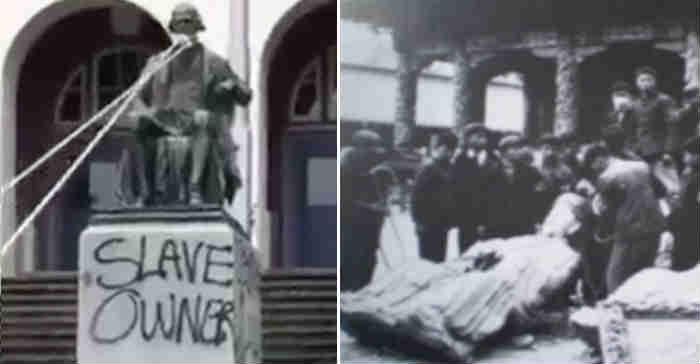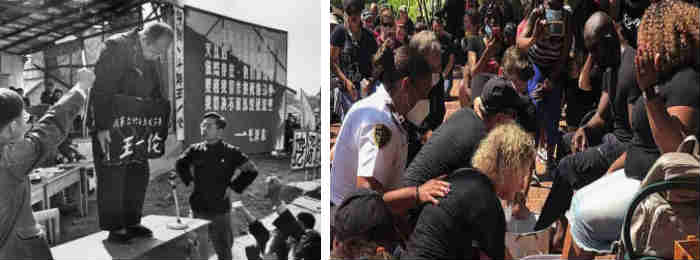By Lee Cary ——Bio and Archives--July 23, 2020
American Politics, News | CFP Comments | Reader Friendly | Subscribe | Email Us
 The Chinese Communist Party's Cultural Revolution (1966-1976) was the precursor to today's urban protests involving Black Lives Matter (BLM) and Antifa.
As America's Cancel Culture spread into several Big Blue Cities, largely governed by Democrat politicians for decades, city officials stood back and let it happen.
The Chinese Communist Party's Cultural Revolution (1966-1976) was the precursor to today's urban protests involving Black Lives Matter (BLM) and Antifa.
As America's Cancel Culture spread into several Big Blue Cities, largely governed by Democrat politicians for decades, city officials stood back and let it happen. "For several years, students had been brought up in the militant doctrine of 'class struggle', and the Socialist Education Campaign had warned them of class enemies lurking in every corner, plotting to over throw the party." (p. 54)
"Red guards began physically attacking teachers and administrators the moment they heard of Mao's battle cry 'To Rebel is Justified.'" (p. 73)
"The first death occurred in a girl's school administered by Beijing Normal University. Bian Zhongyun, the vice-principal…students spat in her face, filled her mouth with soil, forced a dunce's cap on her head, tied her hands behind her back and then beaten her black and blue…When she finally reached the hospital across the street two hours later, she was pronounced dead." (p. 73)
"The real founding of Red Guards was a campaign to destroy all remnants of old society. On 18 August [1966], appearing on the rostrum next to Chairman Mao, Lin Biao had exhorted his youthful audience to go and destroy 'all the old ideas, old culture, old customs and old habits of the exploiting classes'. Feudal ideology had fettered people's minds for thousands of years, and now these cultural remnants were to be destroyed to ensure that the country's revolutionary colour would never fade. Tradition was the dead hand of the past trying to maintain its grip on the living, and it was to be smashed to smithereens." (pp. 80-81)
Support Canada Free Press

"On the evening of 20 August [1966], bands of Red Guards began roving through the streets of Beijing, attacking anything that smacked of the old order. They changed street names, plastering new revolutionary terms over old signs. Shops providing services, for instance tailors and barbers, came under attack, as their owners were humiliated, sometimes beaten and forced to close down." (p. 81)
"Public monuments were assailed. In Shanghai, it took the Red guards only a few days to demolish eighteen listed historical monuments…The Confucius Temple, an ancient architectural complex located in a quiet public park, was razed to the ground. Red Guards also tackled St Ignatius Cathedral…tearing down the spires and the ceiling before shattering its stained-glass windows…a report later established that 'All the articles of worship inside Catholic churches have been destroyed.'" (p. 84)
"[T]he Red Guards lined…their pockets with money, jewelry and wristwatches, openly appropriating radios and bicycles in the name of the cause. The school dormitories suddenly became plush. Many students were enjoying themselves there with their loot. There were also common thieves who impersonated Red Guards, doing the rounds to seize their share of the booty." (p. 90)
"Whole categories of people became unemployed. In Nanjing, the number of jobseekers increased tenfold. There were florists, greengrocers, fruit sellers, cobblers, tanners, coppersmiths, papermakers, printers, photographers, painters, dressmakers, embroiderers, bookbinders, undertakers and others. Many were ruined because their shops were forced to close down, while others could no longer make ends meet. The vast majority were poor people." (p. 94)
"The effects of the Cultural Revolution reverberated throughout the industrial sector. The labelling, packaging and contents of every single manufactured product, from toys, textiles, cosmetics and appliances to porcelain, had to be purged of all remnants of the feudal past. A pair of socks, a tube of toothpaste or an enameled washbasin branded Fairy or Golden Pagoda was an insult to the proletariat. The State Council demanded strict compliance with the demands of the Cultural Revolution, but in Shanghai alone there were close to 6,000 products with a label or design evocative of the past. It took years of overhauling to conform." (p. 95)


"In Beijing, where most of the killings took place, public acts of violence by Red Guards began to abate in the first days of September [1966] and then seemed to cease altogether. The police were in charge again…The lull did not last. The flames of the revolution had to be constantly rekindled, and on 31 August another mass rally was organized in Beijing. This time the Chairman (Mao) called upon the Red Guards to apply their revolutionary experience to other parts of the country. On 5 September, the State Council announced that travel, board and accommodation would be free to all Red Guards." (p. 101)So, who started the Cultural Revolution there and then? And who started the Cancel Culture here and now?
View Comments